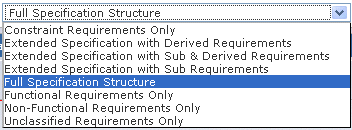View and Display Options: Structure & Content Editor | ||
| ||
Effectivity Filter
Below the toolbar, an Effectivity filter allows you to filter the display of objects by their effectivity:

For information about using the effectivity filter, see Filter Effectivity for Display.
![]()
Expansion Filter Options
- From the Expansion Filter drop-down menu, select an option.
The navigation tree and work area are updated according to the selected option.

List of Expansion Filter options:
Constraint Requirements Only. Displays objects that have a classification attribute that is blank or set to Constraint.
Extended Specification with Derived Requirements. Displays all derived requirements in the specification.
Extended Specification with Sub & Derived Requirements. Displays all sub and derived requirements in the specification.
Extended Specification with Sub Requirements. Displays all sub requirements in the specification.
Full Specification Structure. Displays all objects.
Functional Requirements Only. Displays objects that have a classification attribute that is blank or set to Functional.
Non-Functional Requirements Only. Selects objects to display that have a classification attribute that is blank or set to Non-functional.
Unclassified Requirements Only. Selects objects to display that have a classification attribute that is blank or set to None.
![]()
Display Options
-
From the Display Options drop-down menu, select a display option.
The work area changes depending on the option selected.
Below is a description of the options:
Tabular. Displays objects in tabular format, with one object in each row.
Resize the columns by dragging on the right side border of the column heading. Default column widths for regular and rich-text fields are set on the Setting page. See Make SCE Settings.
If sorting is enabled, click on a sortable column heading to sort the rows by its attribute.
0px, 10px, 20px, 30px, or 40px. Displays objects indented by the number of pixels selected. The first indent is applied after the Specification level and then to all subsequent child and chapter levels.
If sorting is enabled, click on a sortable column heading to sort the rows by its attribute.
![]()
Customize Table View
To build a customized view of the table which controls the viewing of the Structure Content Editor, click View on the page toolbar.
A page displays table options you can work with. For a description of this page, see Designing Your Own Page Views.